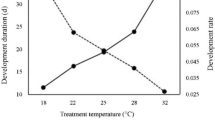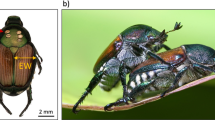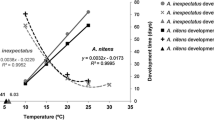Abstract
The results of this investigation prove thatPhorodon humuli does not require a distance flight phase before settling on the winter hosts: Classified according to the distance from hops, 86% of the plants up to 20m were colonized, only 43% of the plants in a range from 20 to 100m, 25% in the 100–1000m class and only 17% with more than 1000m distance. These results were obtained withPrunus domestica. P. padus was not colonized at all and withP. spinosa in only the first two classes ranging up to 100m distance settling could be demonstrated, but at a low level of 7 and 8% respectively.
Observations of a single tree demonstrate a loss of more than 90% of the fundatrices in advance of colony-formation. Furthermore, a preference of those parts of the tree with a southern orientation for settling, egg-laying and colony-formation was shown and this could be confirmed by observations with other trees in the following years.
Zusammenfassung
Die Daten der vorgelegten Arbeit belegen eine starke Besiedlung des WinterwirtesPrunus domestica durchPhorodon humuli in nächster Nachbarschaft des Sommerwirtes Hopfen, mit abnehmender Tendenz in Abhängigkeit von der Distanz zu diesem. Die Besiedlung vonPrunus spinosa zeigte dieselbe Abhängigkeit, war aber insgesamt gering. Beim herbstlichen Wirtwechsel ist also eine Distanzflugphase offenbar nicht notwendig.Prunus padus wurde nicht besiedelt. Die aus den Wintereiern schlüpfenden Fundatrizes erlitten hohe Verluste. Die Zahl der zur Fortpflanzung kommenden Tiere lag nicht über 10%. Die Besiedlung des Winterwirtes erfolgte mit einer sehr deutlichen Präferenz für die nach Süden ausgerichteten Pflanzenteile.
Similar content being viewed by others
Literaturverzeichnis
Campbell, C. A. M., 1977: Distribution of damson-hop aphid (Phorodon humuli) migrants on hops in relation to hop variety and wind shelter. Ann. appl. Biol.87, 315–325.
Eppler, A., 1986: Untersuchungen zur Wirtswahl vonPhorodon humuli Schrk. I. Besiedelte Pflanzenarten. Anz. Schädlingskde., Pflanzenschutz, Umweltschutz59, 1–8.
Goethe, J. W., 1824: Von dem Hopfen und dessen Krankheit Ruß genannt. Zur Naturwissenschaft überhaupt, besonders zur Morphologie2, 74–76 (zitiert nachKolbe).
Kolbe, W., 1966: Untersuchung über die Bekämpfung von Blattläusen und Spinnmilben im Hopfenbau. Bayer. Pflanzenschutz-Nachrichten19, 193–246.
Taimr, L., Holman, J., Křiž, J. undKůdelova, A., 1978: Large-scale radiophosphorus marking of the hop aphid (Phorodon bumuli Schrk.)in situ on the primary host. Z. ang. Ent.86, 145–160.
Theobald, F. V., 1926: The plant lice or Aphididae of Great Britain. Vol. I.Phorodon bumuli, Headley Brothers, London.
Zattler, F., 1965: Versuchs- und Forschungstätigkeit des Hans Pfülf Institutes für Hopfenforschung im Jahre 1964. Hopfen-Rundschau16, 234–239.
Zohren, E., 1970: Möglichkeiten einer integrierten Bekämpfung von Hopfenschädlingen. Z. ang. Ent.65, 412–419.
Author information
Authors and Affiliations
Additional information
Mit 5 Abbildungen und einer Tabelle
Rights and permissions
About this article
Cite this article
Eppler, A. Untersuchungen zur Wirtswahl vonPhorodon humuli Schrk. II. Besiedlung der Winterwirte. Anz. Schadlingskde., Pflanzenschutz, Umweltschutz 61, 44–48 (1988). https://doi.org/10.1007/BF01906253
Issue Date:
DOI: https://doi.org/10.1007/BF01906253




